I recently relocated to Guam, but in the months before I did, I had the opportunity to spend a few months visiting my childhood home in Connecticut. This gave me a wonderful opportunity to reconnect, not only with my family, but with the land that was both the backdrop and steady companion of my childhood.
Personal relationship with the land can take many forms. Some people build a relationship with their land through frequent outdoor activities that put them in close contact with nature. Others plant flowers or crops, working with the land to cultivate life. Still others seek relationship with land through a broader lens, focusing on their role in the larger pictures of sustainable living and climate justice.
But for children, relationship with the land is sometimes as simple as play.
As a child, I treated the land as a multi-layered space. On the surface, my backyard was just that: a backyard. It had property lines and telephone poles and all the things it needed in a mundane world of real property rights. But there were other meanings that could overlay the mundane, other worlds that could co-exist in that space. This is not uncommon for children; Jesse and Leslie had their Terabithia, and I had…well, I need not share all my secrets with you, Dear Reader. Still, know that I spent a lot of time in the spaces that overlaid those Connecticut forests, and they were incredibly formative and meaningful for me (see my Hero’s Journey entry for Night 10: The Road Back).
The forests in Connecticut are so different from those in Colorado. They move differently in the wind. The aspens in Colorado twinkle as each leaf flashes in the light like a spinning coin, twisting and fluttering, and that sparkle of movement tracks the wind across their canopies. They are dynamic, vibrant, even ecstatic in their interconnected dance. “Like a flock of birds,” as Dr. Grant would say, they move together. A choreographed response to the wind, even as each leaf flashes its own light.
But the trees in Connecticut, those oaks and maples, move differently. They stand tall and stark, frayed at the top, and the stillness of their deep layers upon layers of narrow trunks are almost imposing. Then the wind moves through their multitudes, and they roar to life. You can see the wind coming, not through the canopies like you can with aspens, but through the body of the forest, barreling through the trees like a wave, each trunk bending nearly in half. I remember standing among them and watching them swing about wildly, then dip low in the wind as if leaning in to inspect their small, fragile visitor more closely.
These were the trees of my childhood, and perhaps, any one of them could have been appropriate for my project. Any one of them could have provided the connection to home that I wanted to carry with me to Guam. But if I was serious about my project, about tapping back into the sacrality of this land that I recognized when I lived here, then I needed to do this right.
I had to go home. I had to visit my tree.
So, I did. It was trespassing. I know. But I’ve always been more of a Chaotic Good alignment, and I have no shame or regrets about the decision.
Snaking my way between fences and tree lines, I made my way to the narrow strip of woodlands from my childhood. The trees had not started to bud yet, and I was struck by how close the river at the edge of the woods really was when the foliage is missing. But the distance is deceptive—these are not woods you can safely cross in a straight line. These woods were wetlands, and it takes familiarity with the firm paths lacing among the invisible muddy pitfalls to navigate without getting stuck. The complexity of the land, the length of the twisting paths it contains, made the space feel more expansive than it was. In the summer, the low branches and skunk cabbage create green corridors through the woods, and we would clear a maze of trails through the knee-high skunk cabbage to make it easier to avoid the mud. But in the winter, I had to rely on my memory of those trails. I am proud to say, I emerged clean and dry.
Because of the type of forest this was, riddled with deep pools and mud hiding under the leaves, right-relationship with this land had always required a walking stick to test the ground ahead of your feet. We each had our own, carefully selected walking stick. When we invited new friends to the house, part of the ceremony of introducing them to our back yard was helping them choose their own stick for the woods. They were all stored together, leaned carefully against the same tree between our quests and excursions. They may have looked like just a pile of sticks, but not to us. Everyone knew their own waking stick. Some we recognized by their unique knots and whorls, and others by the initials or symbols we carved in their handles with the broken tiles we found in the woods. Like Gandalf trekking through Middle Earth, we carried our walking sticks through all our adventures.
I always liked finding a new walking stick. There is a very particular shape I looked for in walking sticks: about an inch in diameter at the handle, maybe less; tapering at the bottom, but not so narrow as to wobble; as straight as possible from its handle to its tip so it can prod the muddy leaves without bending; and smooth from shoulder to elbow height so it would be comfortable in your hands. It was not a particularly rare shape in these forests, but not so common that it didn’t take patience and discernment to find.
So imagine my joy at finding such a perfect walking stick waiting for me, there at the bottom of my tree.
And when I came seeking support on my next adventure across unfamiliar, uncertain terrain, it gave me a staff to guide my steps.
Reciprocity. With full honor and thanks, I accepted.
I’ve never had a rune set with personal significance, and I wonder if it is why I have always struggled with the divination portion of the COoR at home. Still, I felt that if I was working with a tool that was a familiar guide, something that I could trust in and find meaning in from its mundane materials, even absent the symbols of the runes themselves, maybe they could have the significance I was seeking. Now, I hoped that maybe the numinous quality of that staff, representing the walking sticks that guided me through those labyrinthian paths in the woods, could import those same feelings to my runes. That way, even if the runes themselves failed to reach me, I would always know that I still had that guiding piece of history, that link to the worlds and experiences that had meant to much to me as a child.
So I started my project.
* * *
I started by sawing off 25 rounds from the walking stick. I choose to work from the section of the stick that I would have held if I were using it as a staff, navigating the woods: the smooth section from shoulder to elbow height. I liked knowing that the runes would be taken from the portion of the staff I would have held, like a guiding hand. I kept the rounds in order as I sawed them off, then lightly traced the rune on each one in the sequence they were cut from the staff.
Those of you who know the runes will notice I have one extra. Before I knew how common a practice this is, and how hotly debated this issue is, I decided I wanted a blank rune. I know that the blank rune is…not canonical. I also know that many people find them duplicative, since Perthro can already represent the unknown. But I wanted a rune to represent silence. I wanted the runes to have the chance to decline to speak, without the connotations that Perthro already carries.
I even considered adding more. As I sawed the blank rune, I was considering sawing off a few more rounds to add symbols for some entities I work with personally: the Nomad, the Midwife, the Scribe. As I was imagining what symbol would best represent each entity, I kid you not…the saw blade broke loose from the handle. I decided I had been given a pretty definitive answer: no more runes. I reattached the blade and finished sawing off the blank rune. I still wonder whether I should interpret that as a comment on the blank rune as well, or just on the thoughts running through my head as I was sawing. For now, the blank rune is still included in my set.
I processed the rest of the staff down into pieces. Some are long flat surfaces that could be inscribed. Others are just offering-sized chunks. I also kept a few longer pieces in case I feel called to erect one as a new World Tree at my altar. In the end, minus the sawdust (left as offering), I was able to bring the whole staff with me to Guam.
After some light sanding to take off the rough patches, I started to inscribe the runes. I used a piece of writing, stating my hopes and intentions in this work, as my movable workspace. It felt appropriate to use a surface of written words to make sacred the space for this type of work.
This was a multi-day process with hours of focused work, but I’m glad I did it in this way. Had I just painted on each rune, I would not have felt the same connection to the symbols. However, when you have to carefully, deeply etch each rune into the wood with a cheap soldering iron that periodically turns itself off without warning, meditating on the meaning of each symbol as you also avoid burning your fingers, you come away from the process with a transformed understanding of these symbols. When you then return to the runes to measure and cut thin gold wire to inlay into each deeply burned groove, delicately placing each gold thread into the rune and patiently setting it with superglue, your relationship with these shapes changes again. And when you return again after the glue dries to sand off the excess glue with a rotary sander, smoothing each rune face until the wire and glue are flush with the surface of the wood and the wire gleams through against the blackened wood, your mind has been altered by the work just as the wood has been shaped.
After sanding the glue, I oiled them with multiple coats of flaxseed oil, and they started to shine.
They may need some gloss eventually, or perhaps a wax coat, but the faces are smooth and even. I can run my fingers across the surface of each one without being able to differentiate the different runes. I can’t even tell the backs from the fronts with my eyes closed.
Head high, eyes clear, and walking stick safely in hand, I’m ready for my next quest.
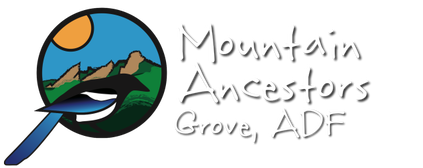
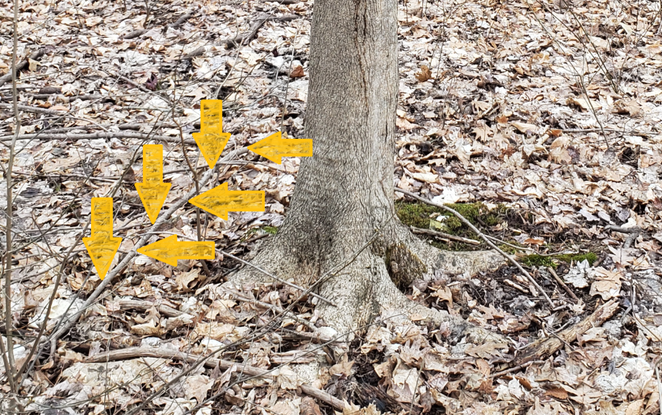
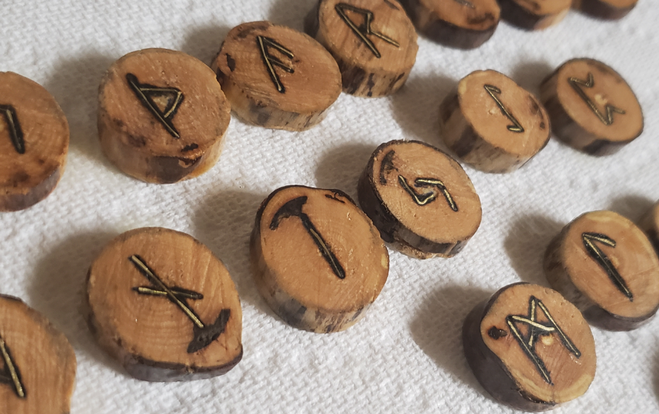
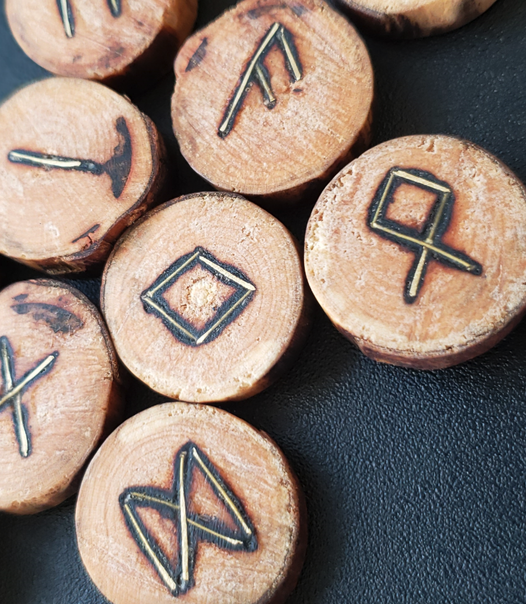
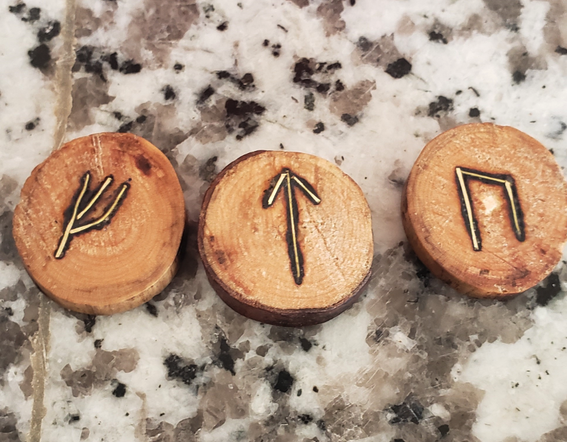
 RSS Feed
RSS Feed
